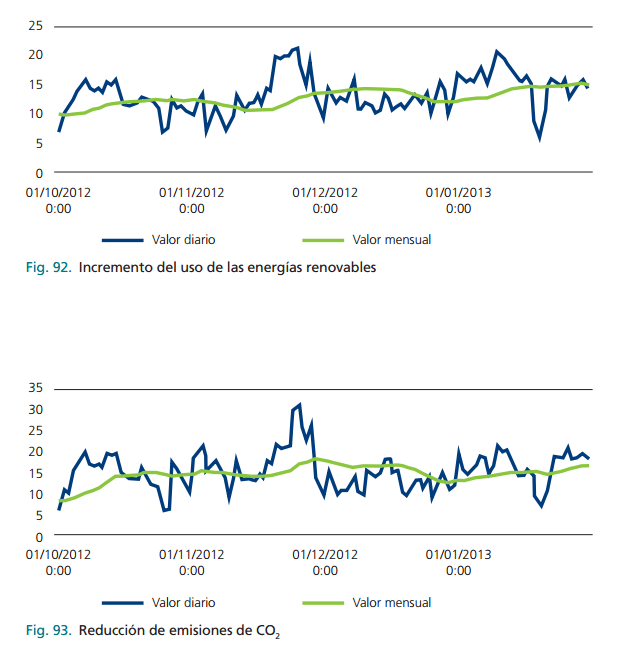-
Phone Number
-
Email Address
The report “Smartcity Málaga: A sustainable energy management model for the cities of the future” supported by Endesa where the actions carried out in an area are detailed of Malaga applying the Smart Grids concept (Improvement and optimization of the electrical system in its set) framed within the Smartcity from its started in 2009 as a test bench for the introduction of Smart Grid technologies in our networks medium and low voltage.
The implementation of this model assumed over an area that covers 4 km2 the modernization of the distribution network electricity in the implantation area, providing it with infrastructures that improve its operation and, at the same time, allow you to expand the range of network functionalities. He deployment of communications, systems, sensors, etc., leaving the door open to future new applications of Smart Grids.

Content menu:


As indicated in the report based on the graphs:
The following graph (fig. 92) shows the evolution temporary increase in the use of renewable energy, in the period of time between October 2012 and January 2012. 2013, through the representation of the values of daily and monthly calculation, that is, of the average value in the last 24 hours or 30 days, respectively. In This graph shows how, despite the fluctuation in the daily values due mainly to arbitrariness and variability of renewable energy sources, the average monthly value of the target is close to 15% in the use of generation from energy sources renewables .
The objective of saving CO2 emissions in the project stands at 20% of annual consumption , which translates into around 6,000 tons of CO2 per year.
This reduction in CO2 emissions proceeds, Fundamentally, the savings achieved in consumption in public lighting, and in high power customers contracted, the residential and SME segment, as well as the reduction of technical energy losses, to the use of electric vehicles, and the generation of medium and low voltage renewables in the area.
In this case, the monthly value is above the 25% This improvement in energy efficiency is based on:
– efficiency of the distribution system , which experiences a decrease in energy demand globally in the area thanks mainly to the high availability and capacity of the cogeneration plant, a flattening of the curve general demand, and a decrease in technical losses at all voltage levels.
– efficiency in energy consumption , which includes all those local actions carried out in the project: decrease in the consumption dedicated to public lighting, reduction in consumption of customers with high contracted power, in the segment residential and SMEs —although each one with its own particularities, increased availability of energy renewable through storage systems and coverage of electric vehicles with V2g technology, and greater efficiency of the data processing systems used in the project.
————–
I have to comment that the report accurately details all the technologies used and that is of great interest attending to what comes to us in the future. In Málaga has definitely become a testing center necessary to be able to advance and learn about the system electric in terms of technology.
What doesn't quite convince me about the report are the graphs that possibly represent the most important points facing the consumer, are aborted generically including data about them in an equally generic format without glimpsing clearly in the graph obvious data and according to the objectives to comply.
On the other hand, we can check in the Report (Page 5) and I quote verbatim:
…” Smartcity Málaga represents a world milestone in the development of a new paradigm of the management of the electricity, with brilliant results: the consumption of power has been reduced by about 20% ”…
If we go to pages 130 and 131:
…”42% of the participants have obtained a reduction important in its consumption greater than 10%, while 33% of the participants maintained their previous level of consumption, with variations between +10% and –10%. 25% the rest, on the contrary, has increased its consumption by more than 10% . However, it is not easy to ensure in a study of this nature that the observed changes in the pattern of consumption are motivated exclusively by the installation of these energy efficient devices, since these They can also be due to external causes such as the situation economy of the moment, the replacement of old appliances for new more efficient equipment or the change of use of the dwelling”
I get the feeling – in my opinion – that the data is contradict a bit and that evidently 25% of the users resulting end up consuming more, is not welcome. We know that technologies will play an important role in energy effects but I think we still have a long way to go to be able to "feel" coherent and satisfactory results for the majority of consumers that we are normally the most harmed.
Let's also remember the post we made back in the day Smartcity: Advantages and Disadvantages … HERE
Note: The images used in this post are extracted from the report "Smartcity Málaga: A model of sustainable energy management for the cities of the future.”